 The story of my latest Cardigan starts at Achern, a small city located in the black forest. All over the year there are Naturparkmärkte (local farmers markets) taking place in several Black Forest cities. And the first one this year was taking place in Achern. Marvin and I went there and had a lot of fun! And I bought some regional raw wool :) The Schwarzwälder Spinnstube had a booth there too. They buy wool from local sheep owners, process it and sell it. You can buy wool in all its forms from them. The sell finished products as well as greasy raw wool.Their homepage is mostly in German, but it says that if you’re interested you should feel free to contact them in English. Just in case I got you interested ;) I bought some roving from them at the market. Among others all the 350g of Coburger Fuchs Roving they had with them. The Cobuger Fuchsschaf is a domestic sheep breed from Germany. It is a very robust sheep and it is known for its beautifully colored wool. The sheep my wool is from live nearby in Oppenau in the Black Forest :)
The story of my latest Cardigan starts at Achern, a small city located in the black forest. All over the year there are Naturparkmärkte (local farmers markets) taking place in several Black Forest cities. And the first one this year was taking place in Achern. Marvin and I went there and had a lot of fun! And I bought some regional raw wool :) The Schwarzwälder Spinnstube had a booth there too. They buy wool from local sheep owners, process it and sell it. You can buy wool in all its forms from them. The sell finished products as well as greasy raw wool.Their homepage is mostly in German, but it says that if you’re interested you should feel free to contact them in English. Just in case I got you interested ;) I bought some roving from them at the market. Among others all the 350g of Coburger Fuchs Roving they had with them. The Cobuger Fuchsschaf is a domestic sheep breed from Germany. It is a very robust sheep and it is known for its beautifully colored wool. The sheep my wool is from live nearby in Oppenau in the Black Forest :)
I did not have the heart to dye the wool. It has such a nice color! And so I started spinning the undyed roving very thin and with a lot of twist, which makes a thread sturdier but also more rough and scratchy. I wanted sturdy and the raw fleece already was so coarse that I don’t think it would have made a difference i softness ;) Usually the wool of the Coburger Fuchsschaf is used to make rugs from it (that is if it is not thrown away altogether). That’s how soft it is, haha.
Spinning the roving was harder than what I had spun before. There still were knots in the fleece and some straw and grass here and there what made it harder to spin an even thread. But it was a nice experience to spin something that actually still looks and feels and smells like sheep, it felt so real, you know?!
Because I spun really thin his time I decided to 3ply the threads and I ended up with sport weight yarn with a grist of 425m /100g! Not bad!!
By the time the yarn was finished I had fallen in love with its color and so I didn’t dye the yarn. Although I think it would also look lovely dyed in a light colorway so that you could still see the difference in the red, brown and white fibers.
After the yarn was finished (bathing, drying, winding) I knitted some swatches and decided to go with 2.5mm needles. My gauge was 22 sts x 31 rows = 10 x 10 cm.
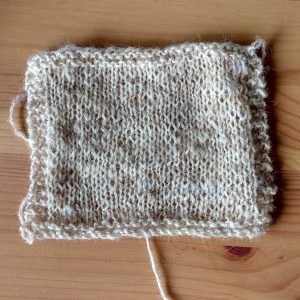
I kept looking for knitting patterns that required a at least similar gauge to mine but I didn’t really find any that I liked. As I knew I wanted something simple I decided to just think of a pattern myself.
I knitted a simple top down raglan cardigan and to make it interesting I placed cables in the raglan ‘seams’, in the side and as well in the sleeve seams. As my construction was in fact seamless it would be more correct to say that I placed cables at places where seams would have been if the cardigan had seams :)
I think the cables match the color and texture of the yarn perfectly. I wouldn’t have thought that this style is for me, but I really like this cardigan and the choices I made.
I knitted the button bands in garter stitch. I have seen that on many baby cardigans lately and I thought I’d try it. I like how it looks but as the button bands are so small this means that the cardigan somethings gapes open between the buttons. I thought about stabilizing the button bands but I think that would have made them too stiff.
The gaping is not only due to my choice of button bands but also because the cardigan turned out a little bit too tight. Especially at my arms. I didn’t consider that I knit tighter in the round, i would have needed to adjust my needles or the amount of stitches. However I hope the cardigan will wear out a little with time ;)
Now a word to the scratchiness of this jacket: this jacket is scratchy :D The wool was very coarse and so the cardigan does not feel nice against my skin. However it is not worse than the Icelandic Lopi yarn I have worked with. And Icelandic wool is something people want to try and buy when they are in Iceland. And if they don’t knit they will at least buy a super expensive sweater hand made from this itchy yarn. Don’t get my wrong the high price is absolutely justified. I’m just so amazed that the Icelandic people where able to sell the scratchiness of their wool as a feature or a sign of quality. That is so clever.
And I’m a little sad that almost nobody seems to be interested in yarn from local European sheep (except Icelandic that is), especially Coburger Fuchs, its natural color is so beautiful. But instead the breed was almost extinct some decades ago and the wool is often thrown away. And all the big yarn producers only sell yarn from merino sheep living somewhere super warm, super far away, sometimes in bad conditions even. That is such a loss! I mean yes the wool is much finer and ofter than but now that I know the difference I think it also less interesting, a little dull even and with less character. I’m so glad I started spinning, I cannot tell you how much fun it is to make your own yarn from any breed of sheep you want, from sheep that live nearby and lead a happy live being outside all day. And you automatically learn about the breed and you get to knit with such interesting yarns! :) .
Also I think tis cardigan will outlive me, I don’t think anything can destroy it, it is super sturdy! And although I have a lot of Cardigans in my closet at this point this one is special to me, I hope that I will look at it in 20 years and remember all the fun I had making it :)
If you want you can have a look at this project on Ravelry here. And if you’re interested in buying wool from the Coburger Fuchsschaf don’t hesitate to ask me for help. If you know a little German here is another website where people sell yarn and roving from happily living Coburger Fuchsschafen, just because they like the breed so much and want other people to use the wool for something instead of throwing it away :)
Macht’s gut!
Katharina


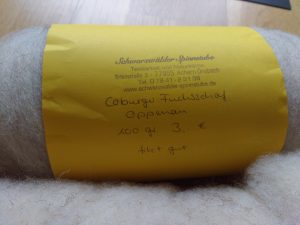
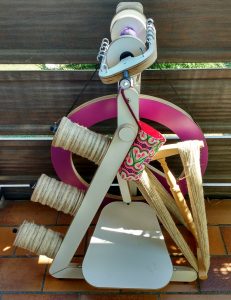
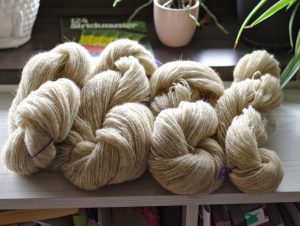

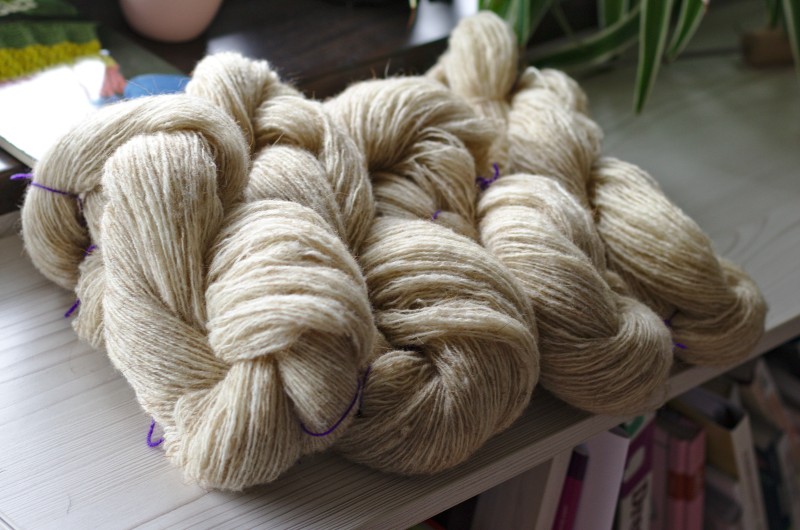

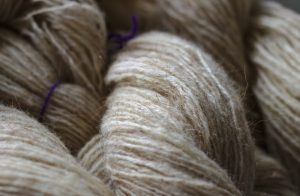

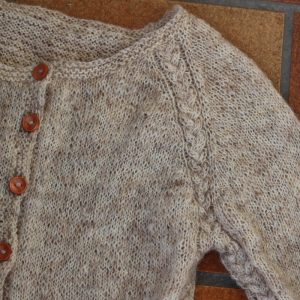

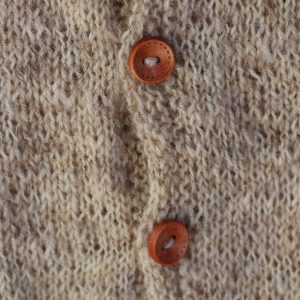
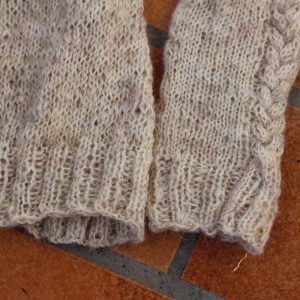
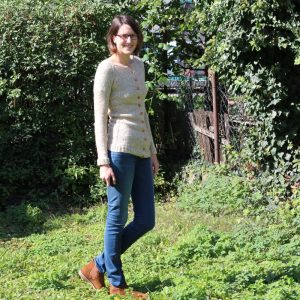
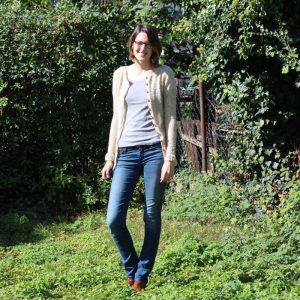

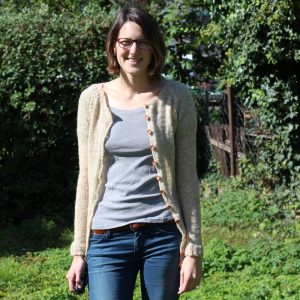

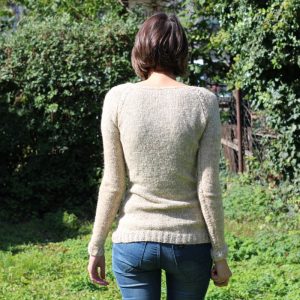
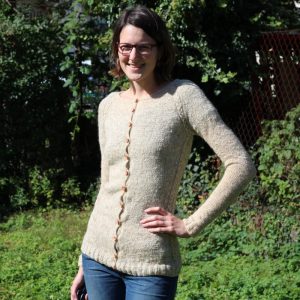

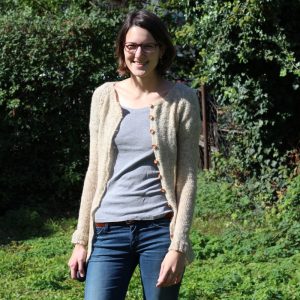
I love you cardigan and admire you efforts to knit from local wools. I prefer a rougher wools to super soft and processed merinos. I feel like they last longer.
I moved to Canada a few months ago and went to a local yarn store to look for locally produced wool. Two stores told me there aren’t wool sheep in Canada! Not true at all. I eventually found a fabulous mill only an hour north of where I live.
Thanks Naia :)
I’ve also made the experience that rougher wool lasts longer.
It’s a little shocking that people working in the yarn business do think that there are no wool sheep in Canada. I bet there are yarn store owners here in Germany who would claim the same thing. Grown ups are making fun that children do not know how cows look. But I have the impression that most grown ups do not know how yarn is made, even if they own a yarn store. And that loss of knowledge and culture saddens me. Who knows what else got lost and of what great things I don’t have knowledge!
Great work!!! I really liked your post, madr me want to learn to spin <3
Your cardigan looks lovely.
Thanks Juliana :) You should give it a try, it is lots of fun! :)
This is outstanding! I’m in awe of your beautiful spinning and knitting prowess. You really area master! that spun wool looks like perfection to me. I think it’s great that you are supporting a local type of sheep and using what looks like beautiful wool, what a shame that people just throw it away! they should not! however I just wanted to say that you mentioned that Australian merino is sometimes grown in bad conditions; that is completely incorrect. Our wool industry is very important to us and as a result we take very good care of it… there are pretty strict guidelines to ensure that sheep here are well cared for and that animals are healthy and happy. They are always free to roam about in paddocks and are not kept in bad conditions at all. Australian merino is world renowned for its superior quality, performance and durability for a very good reason, because it is great stuff :)
Thank you Carloyn! :)
And thank you for sharing your view and getting a discussion going!
Here‘s the Wikipedia article on Mulesing. A practice that is only done in Australia, because only there Merino Sheep are attracted to flystrike. As the article says Mulesing is often done by unskilled persons and often without narcotics. People say there is no alternative to Mulesing, up to 3 million sheep a year undergo this practice in Australia. But I think there is a alternative: not to breed Merino Sheep in Australia, other breeds don’t need to be mulesed, Merino sheep are not affected by flystrike in South America for example. And the very good quality of merino fibers from Australia does not justify treating animals that way, especially when there are in fact alternatives.
What a great sustainable project. The final cardigan is lovely.
I really like the interesting ‘seam’ cables they turn a simple cardigan into something super special.
Thanks Caroline :)
What an interesting post! First…. utterly lovely cardi you’ve created. The bond you feel between the yarn and finished product is clearly evident. Completely agree that it would be great if each country’s local supply chain was supported by that particular country. We certainly have that problem here in America too with so many of our previously made goods now being produced overseas to the point the knowledge is being lost here. It is thrilling to me to see the area I live in become more conscious about where, not only their food is produced, but also where other goods are produced and support the local supply chain when possible. Having said all that…. have no idea about fiber. Thank you so much for sharing not only your beautiful creations with us, but also your thoughts along the way. :)
P.S. With its ‘Golden Fleece’….. you were wise to leave this beautiful fiber un-dyed. :)
Thanks for the kind comment Lisa! I guess that problem exists everywhere in the world as we all get more and more specialized and rely more and more on machines.
Let me also add…. speaking of machines….. when I was touring the Alabama Chanin facility, I understood that one of their product weight knit fabrics was woven on the only machine available in the United States. One machine available?! One?! Blew my mind. Her textile products are all grown, spun, dyed and woven in the United States with one of the processes manufactured right here in South Carolina. Anyway…. so even machines are being affected.? I am very grateful she offers her fabrics to the public. :)
One really does seem not right :D Well, I guess machines are getting bigger and better and people who understand them too. Although I wonder were all the fabric is woven then. There are in total more than this one weaving machine right? This is the only one of its kind, that weaves knit fabric, right? I really hope so! Maybe that is because usually knit fabrics are knit and not woven.
Alabama Chanin sounds amazing :) I’m going to visit the US soon and I will keep my eyes open for her fabrics :)